No products in the basket.
4th October 2018
No.1 Poultry – Relics of Lost London for sale
The busy square outside the Bank of England – “Bank Junction” – is a meeting place of ancient arterial routes at the heart of The City of London; it is ringed by the huge stone classical facades of The Mansion House, The Royal Exchange and The Bank of England. Arriving from the West is “Poultry”, and from the South West “Queen Victoria Street”. On the flat-iron wedge between these streets stood the Venetian-Gothic “Mansion House Buildings” or “No.1 Poultry” of 1870. It became better known as “The Mappin & Webb Building” after the illustrious jewelers who long occupied it. John Maddison of “The Victorian Society” described its incursion into Bank Junction:
“J&J Belcher’s joyfully Gothic “Mappin & Webb” building, marching in among the great classical monuments at the head of an army of variously dressed Victorian mercenaries, points up the scale and grandeur of [the]public buildings, lending historical depth to their content in a way that is the quintessence of the City’s traditional architectural character”.
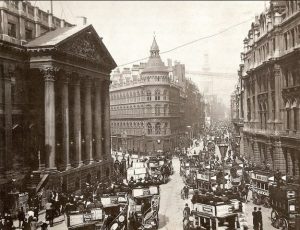
But, controversially, the Mappin & Webb building was demolished in 1994. It was a tragic loss at the heart of the City. Both “The Victorian Society” and “SAVE Britain’s Heritage”, with others, fought a long campaign to save the Victorian building from demolition. LASSCO has some prime artefacts that were shed from the building as it came down – including the Queen Victoria Street doorcase.
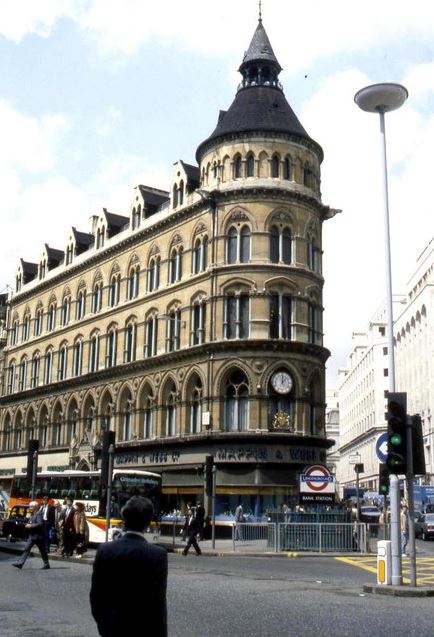
Over time – since 1958 – Lord Peter Palumbo (b.1935) had acquired the freeholds to this landmark site and had let the component leases lapse. The empty site was left to fester as it emptied – intentionally doomed by being hollowed out. A Mies Van der Rohe glass tower was envisioned – “the wrong building in the wrong place at the wrong time” said John Harris as this proposal was scotched by planners. The bitter fight raged through the courts for years but, with forceful persistence from Lord Palumbo, that his site should be re-developed, the wonderful building could not be saved. The stripy post-modern James Stirling building was the ultimate replacement (picture below). On the completion of the latter in 1998, HRH Prince Charles described it as “A 1930’s wireless set”.
The Mappin & Webb Building of 1870 was an early work in the illustrious career of John Belcher RIBA RA (1831-13). He had joined his father’s architectural practice having studied in Paris so was fully versed in Haussmann’s work in the French capital and Neo-Renaissance, and Baroque styles; here though he drew on Ruskin: Venetian Gothic. He went on to design “Whiteleys” in Bayswater (jointly), then “Electra House” in Moorgate, “The Royal Society of Medicine” in Henrietta St, the “Ashton Memorial” overlooking Lancaster – and many more notable buildings and projects including the laying out of the International Exhibition in White City in 1908. He was President of the RIBA from 1904-06.
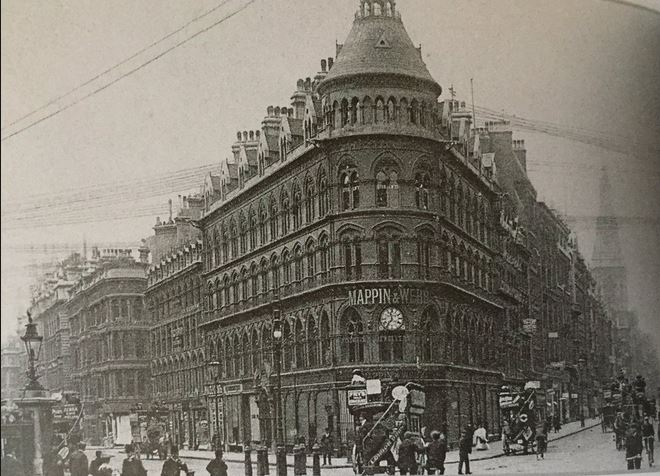
On the demolition of the Mappin & Webb Building in 1996, LASSCO saved the series of large stone gargoyles that projected from the cornice, some other stone elements and, when the demolition reached ground level, we salvaged the enormous stone doorcase – a London landmark that can be picked out in the above pictures. The doorcase was ornamented with two large portrait heads of Gogmagog and Corineus – the pair of giant guardians of the City of London; these portraits in stone had survived the huge wooden figures of the the giants that had stood in the Guildhall since 1708 – the latter were destroyed in the Blitz. Londoners at the Lord Mayor’s Show would have recognised the stone portraits – effigies of the giants were paraded past the doorcase each year. [More info on Gogmagog and Corineus here].
The spired rotunda that capped off the apex of the building was carted away by the victorious Palumbo. His Victorian trophy successively adorned the garden of two houses he owned in the USA – firstly, he had it rebuilt in the grounds of the revered “Farnsworth House” by Mies van der Rohe; in 2003 it was moved to Pennsylvania – the garden of another Modernist masterpiece: “Kentuck Knob” by Frank Lloyd Wright. The conical rotunda stands there today.
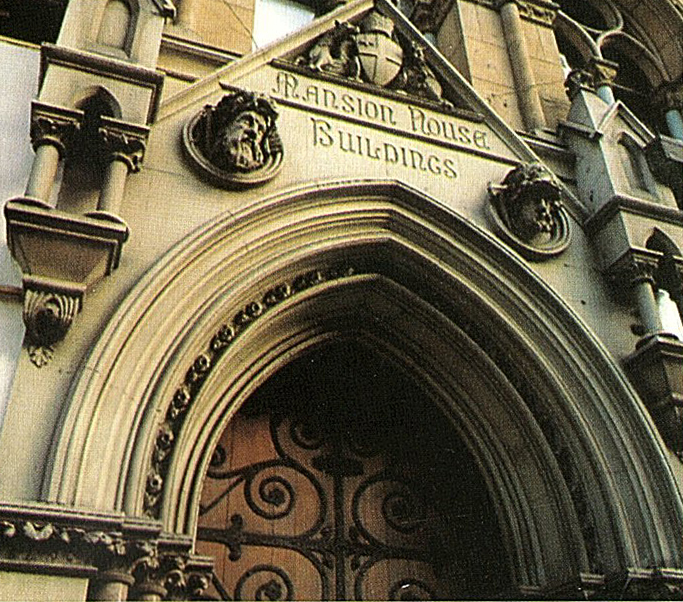
LASSCO, after all this time, can now offer the component parts of the main stone doorcase for sale. It was a spectacular London landmark facing the Mansion House. Firstly the triangular pediment at the top of the doorcase – carved in full relief in limestone: a pair of griffins supporting the City of London armorial shield. The pair of “Romayne” heads portraying the giants “Gogmagog” and “Corineus” – mentioned above – are available as a pair of roundels. The pair of spired turrets that crested the top corners – they could make fabulous gate-pier caps, or simply monumental garden ornaments, are also for sale. The huge portal was held up on massive stone piers – heavily ornamented with clustered pilasters in stone and granite with leafy capitals: this pair form a wonderful entranceway – perhaps gate-piers. The pointed arch they supported is available separately [link pending].
These are important relics of the City of London – beautifully weathered in Portland Stone. They are remembered as much for the fine building they were salvaged from as for the fate that befell them. On view now at LASSCO Three Pigeons.
Other notable Relics of Lost London for sale at LASSCO:
Westminster Bridge, Sir William Chambers’ Doorcase, Sir Charles Wheeler’s Sculptures from the headquarters of Barclays Bank on Gracechurch Street and more ….
Postscript:
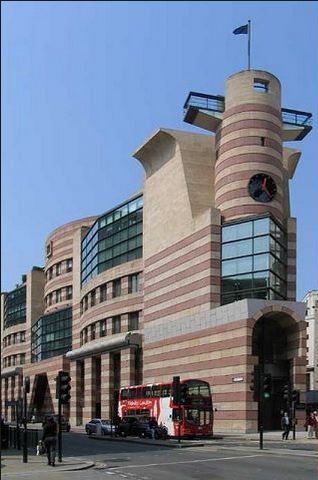
Sir James Stirling’s replacement at No.1 Poultry, commissioned by Lord Palumbo, was granted Grade II* Listed Building status in November 2016 – the youngest building to be granted this protection. In pursuing the Listing, in order to prevent proposed “improvements” to his legacy building, deep ironies were un-earthed – Palumbo had demolished six listed buildings to get his 1998 building constructed. Gavin Stamp commented:
“…[that] the likes of Zaha Hadid and M’Lord Rogers are campaigning for it only strengthens my opinion, … Peter Palumbo has always managed to secure allies. It is, of course, ironic that, having destroyed a valuable concentration of mid-Victorian commercial buildings, some listed, he should now be clamouring for protection for his baby… the man has no real architectural judgement or taste. He remains merely interested in celebrity.
“Having, with many others, fought two public inquiries in the 1980s to defeat Palumbo’s arrogant proposals, only to find successive victories turned into defeats owing to suspect political interference by ministers in Mrs Thatcher’s Conservative government, I really couldn’t care a damn what happens to No.1 Poultry. I just wish the jolly Gothic building by J & J Belcher still stood on the site. It was an object lesson in how to treat an acute corner which was not heeded by the architect of its wretched successor.”

